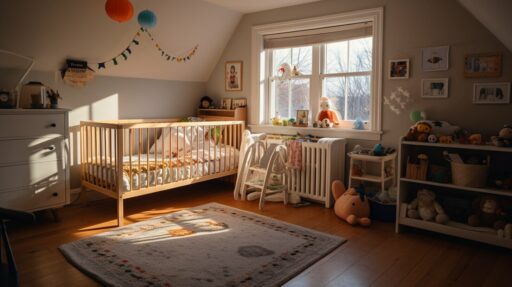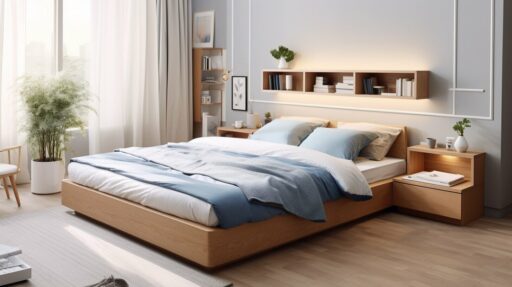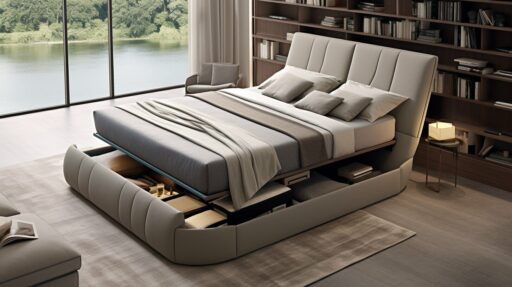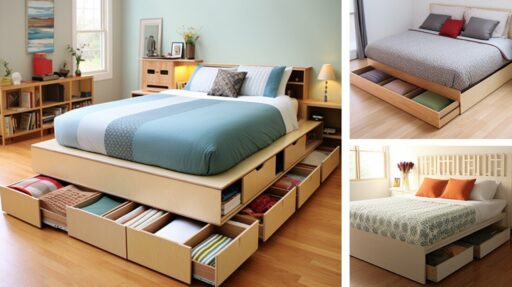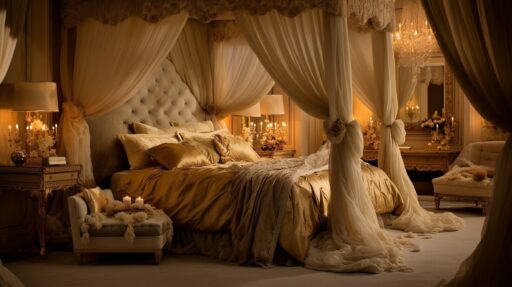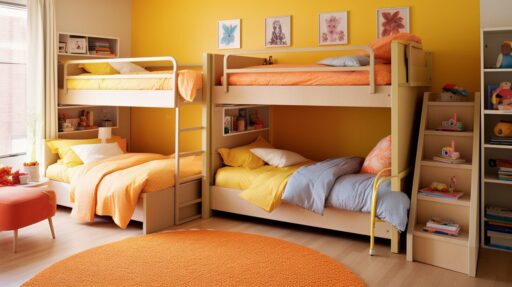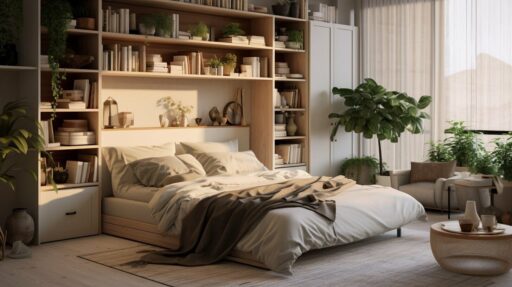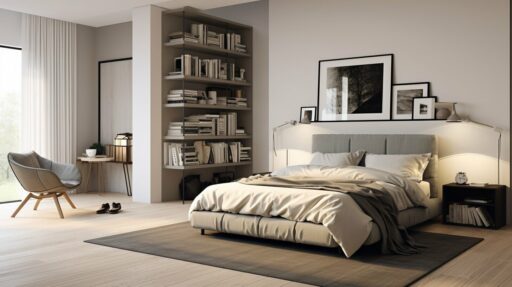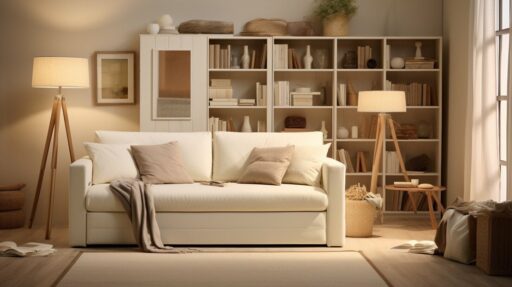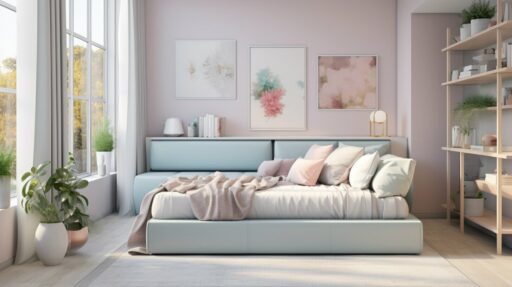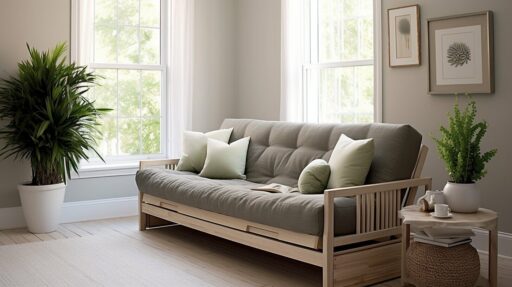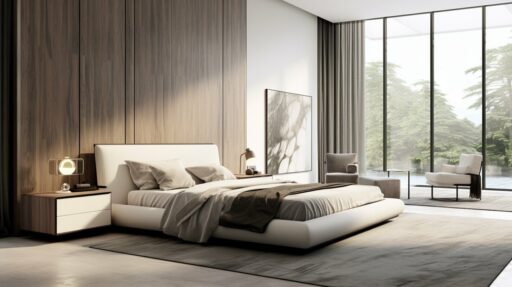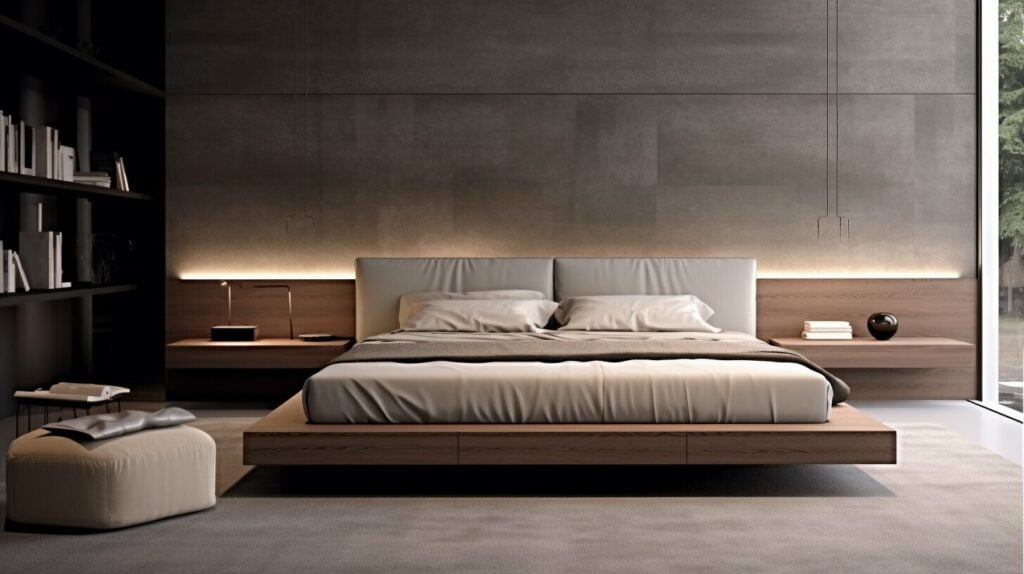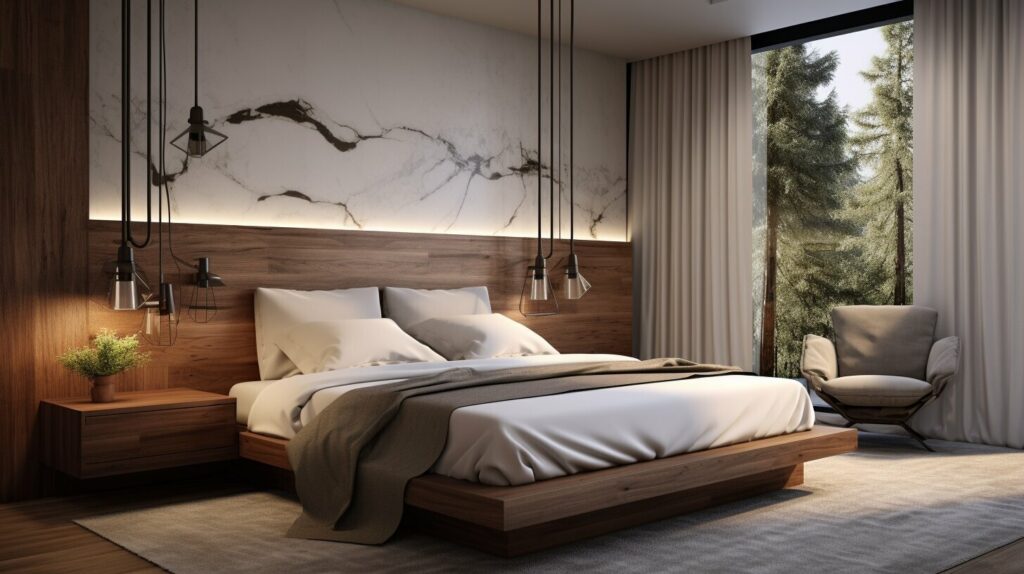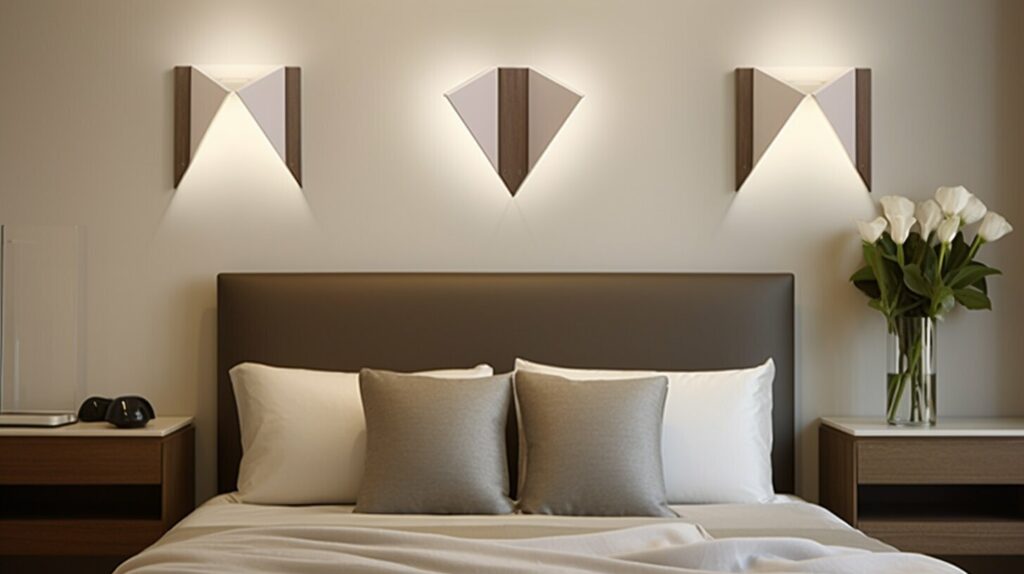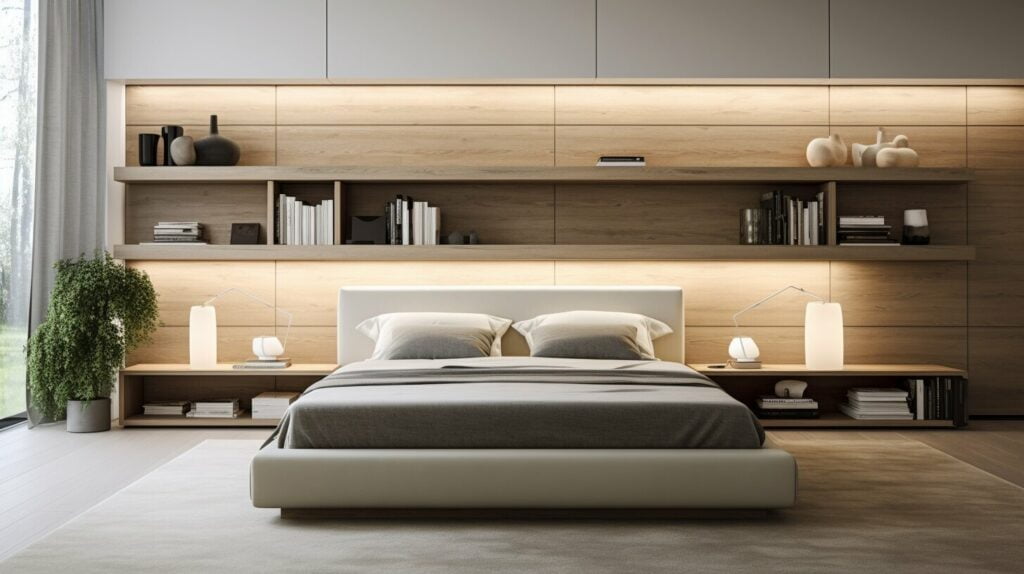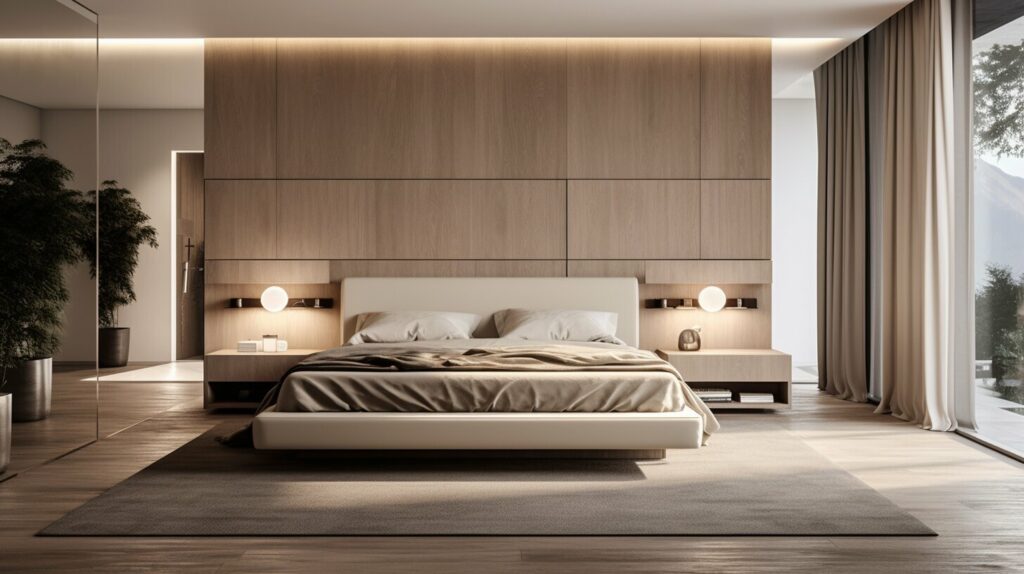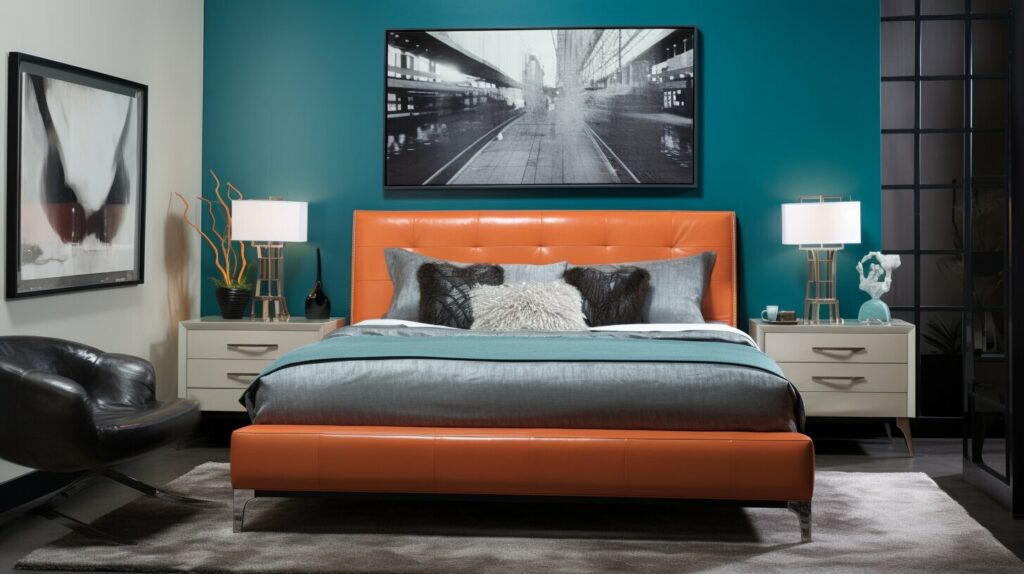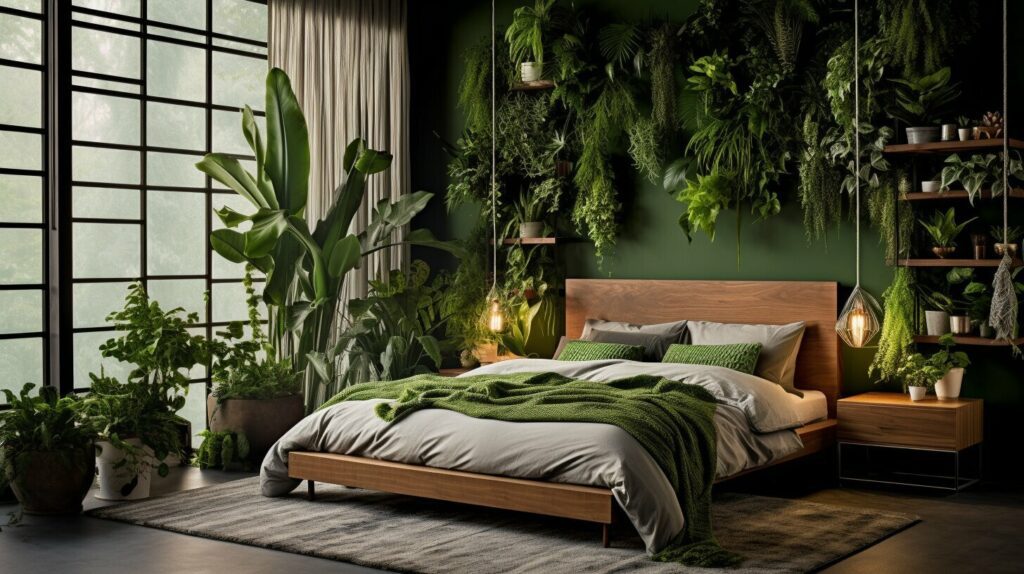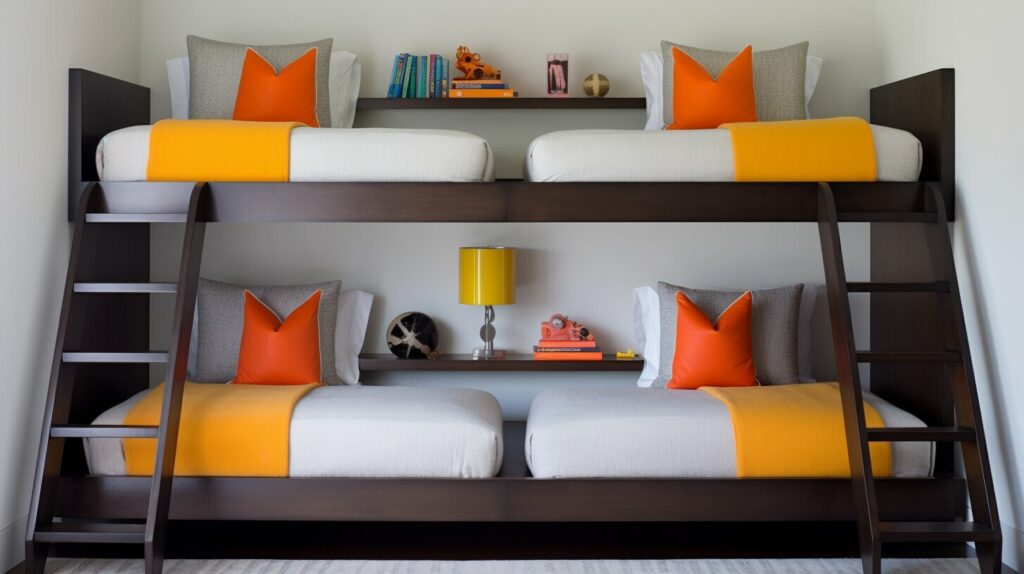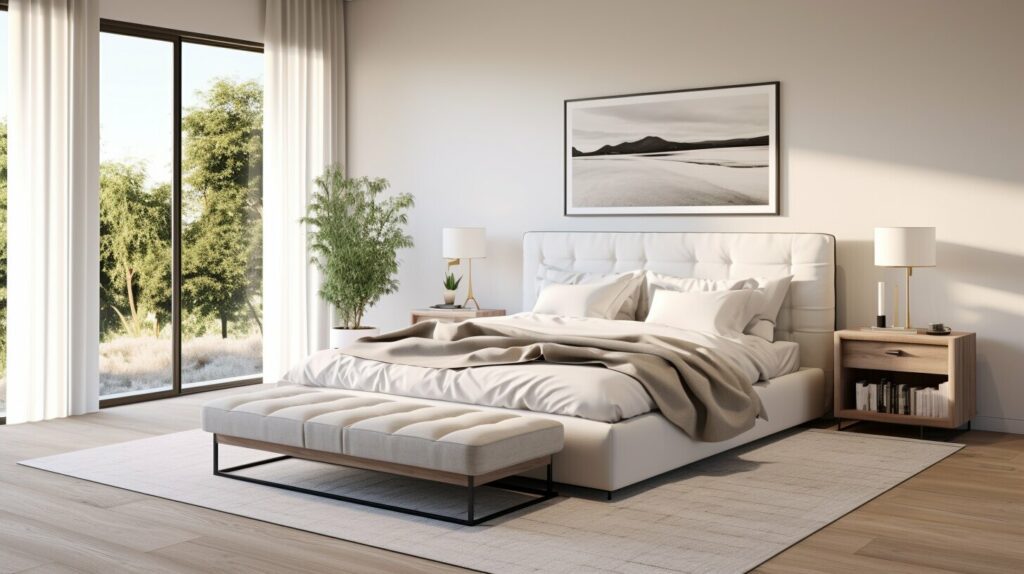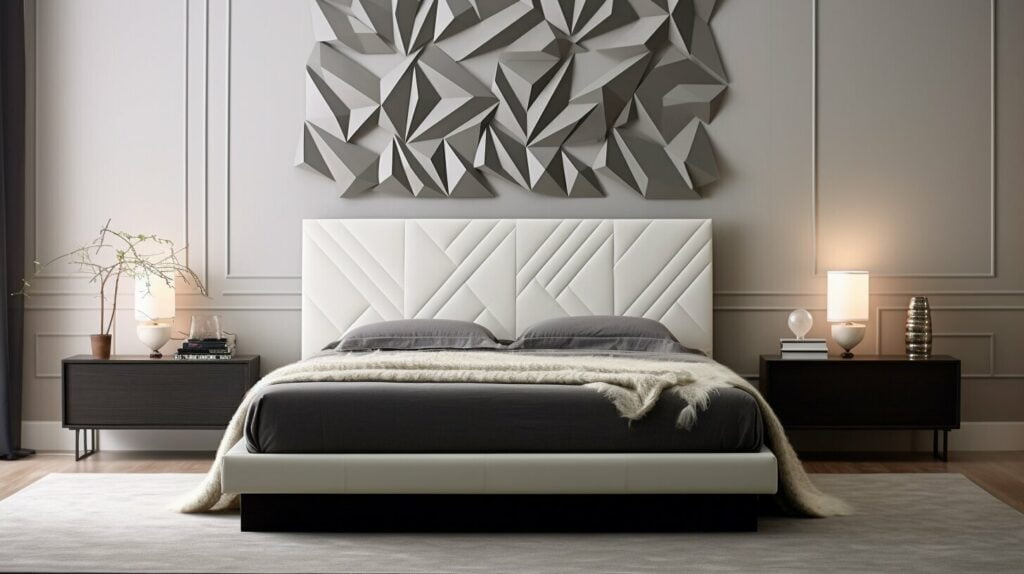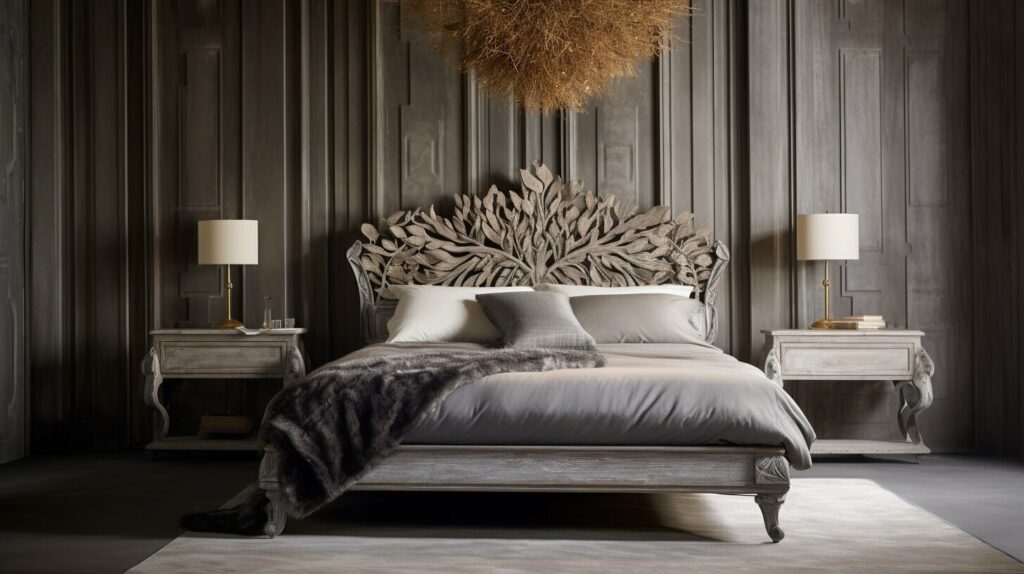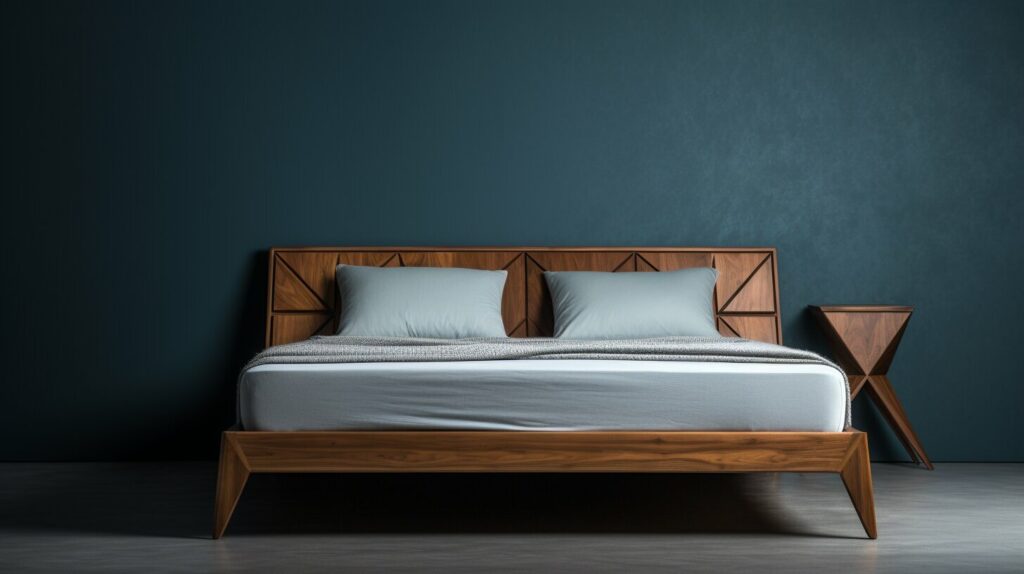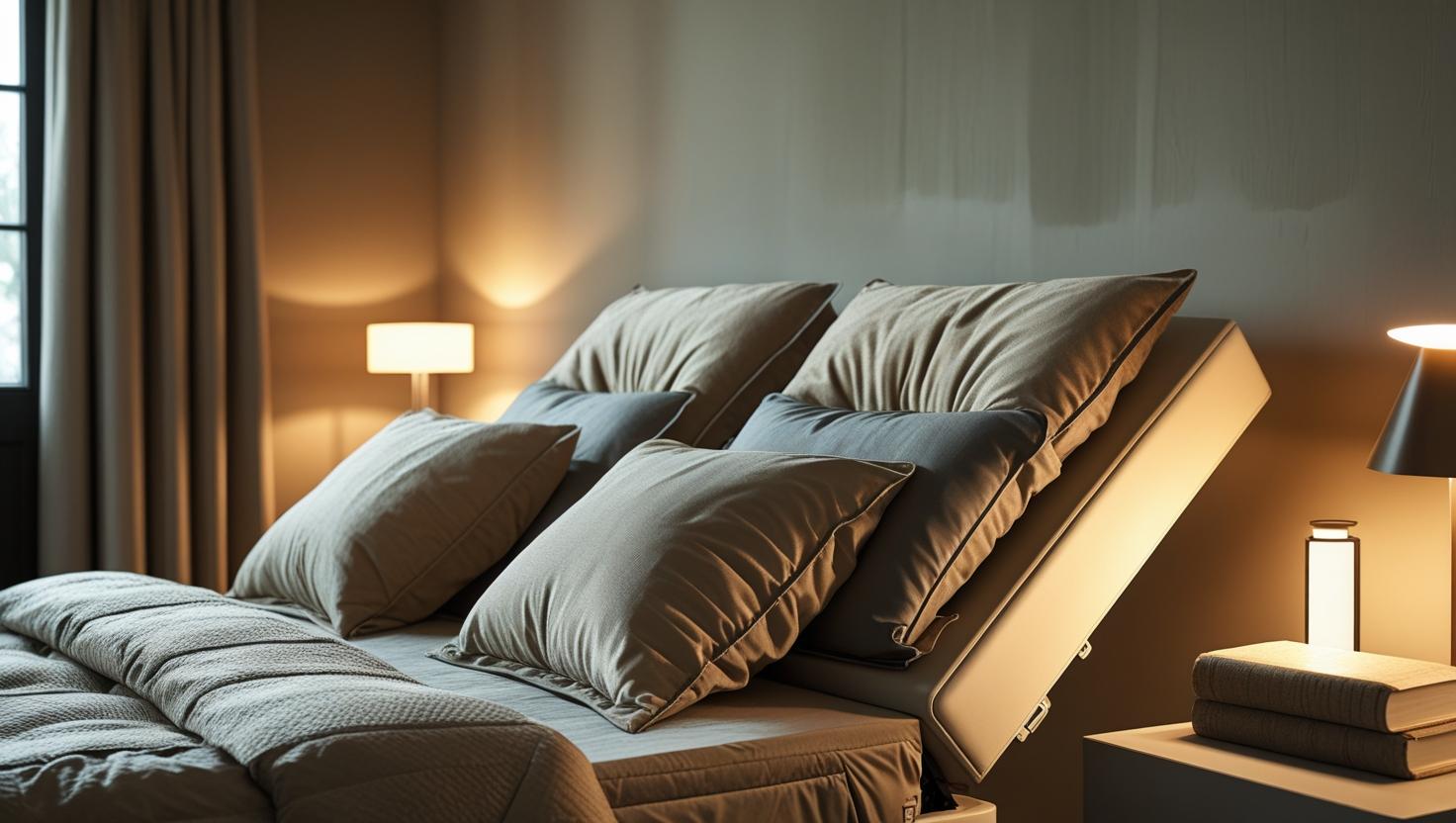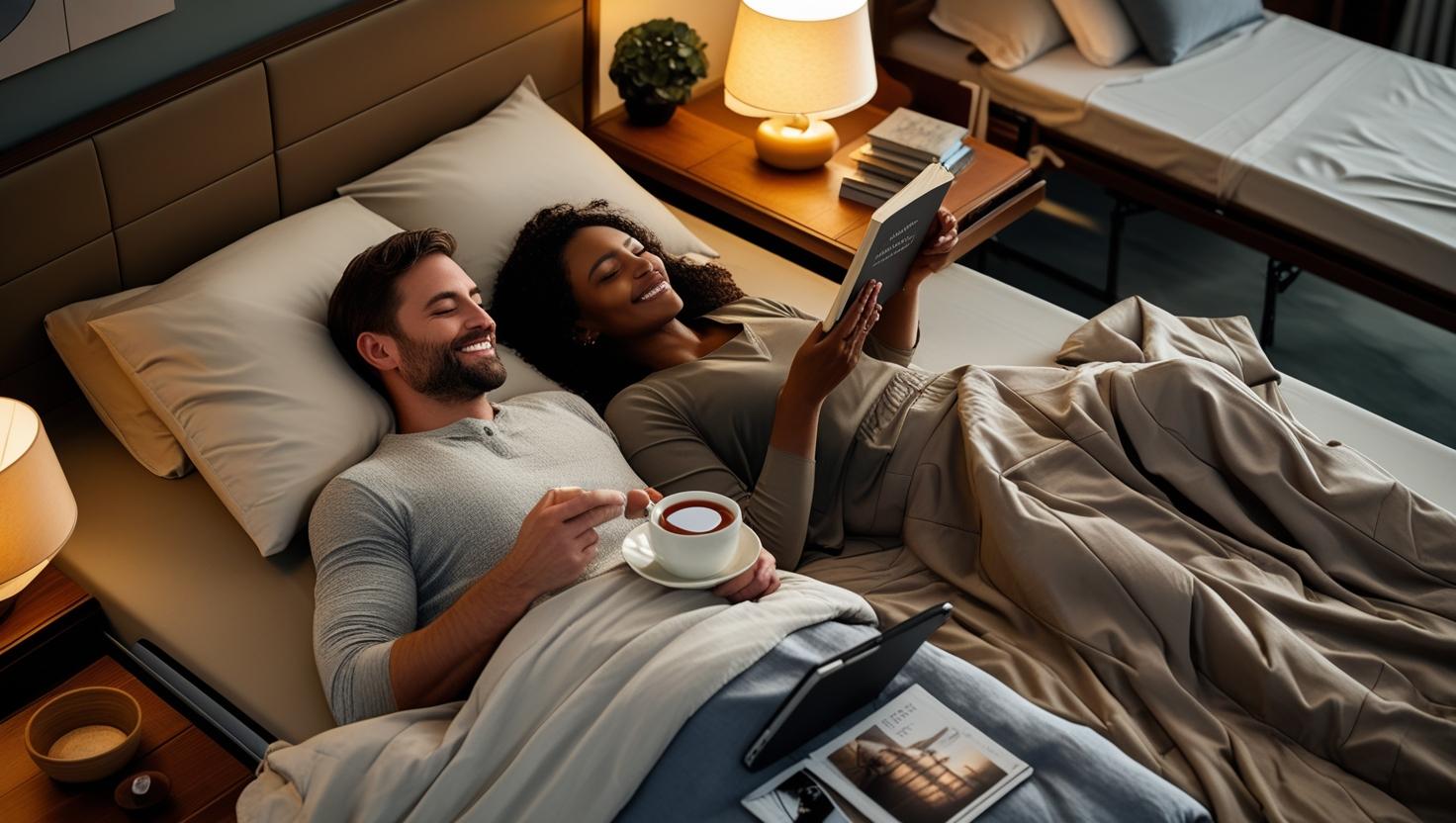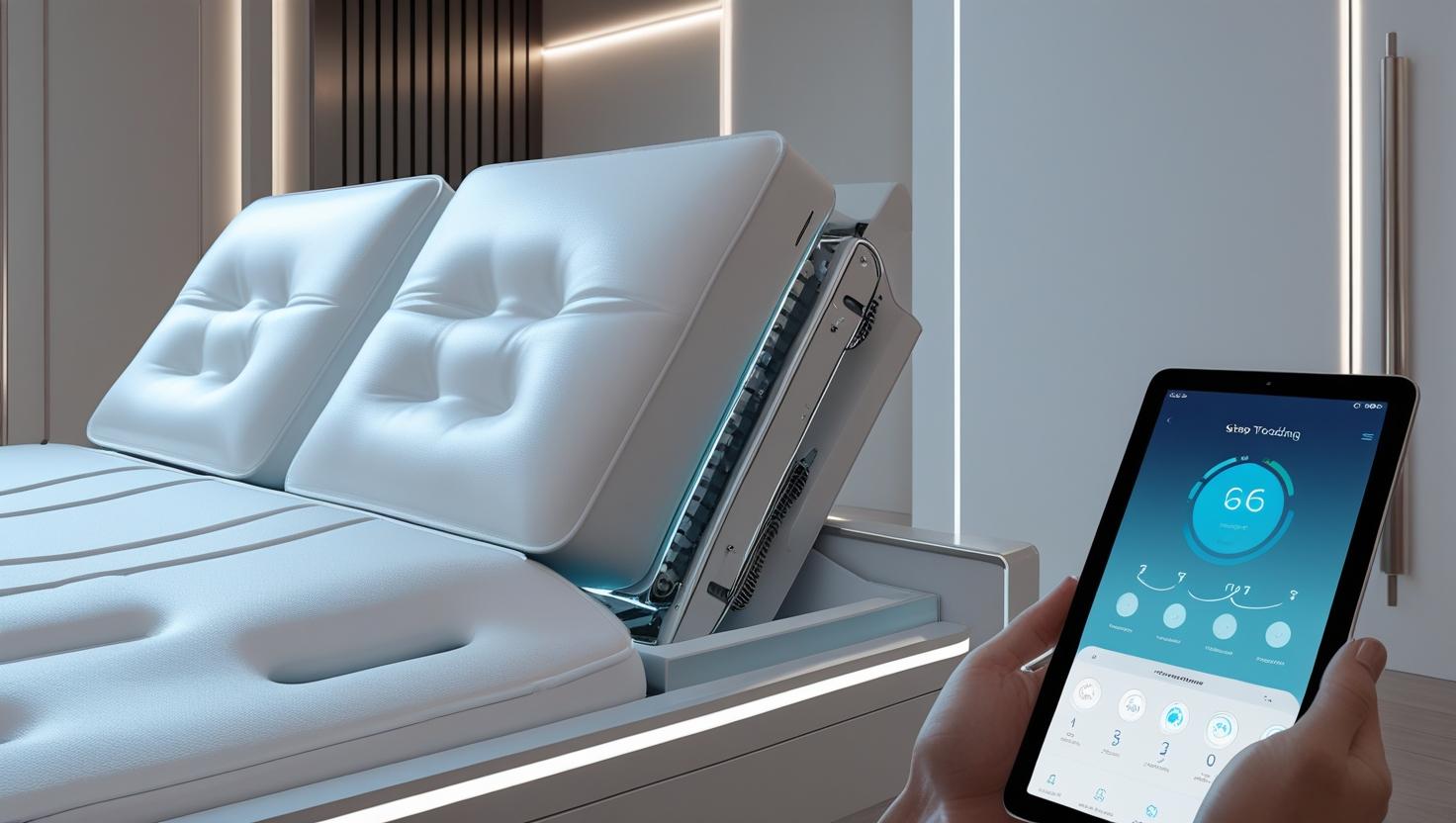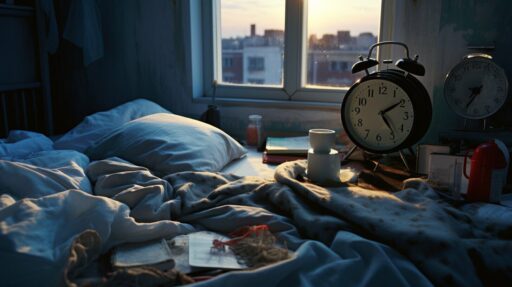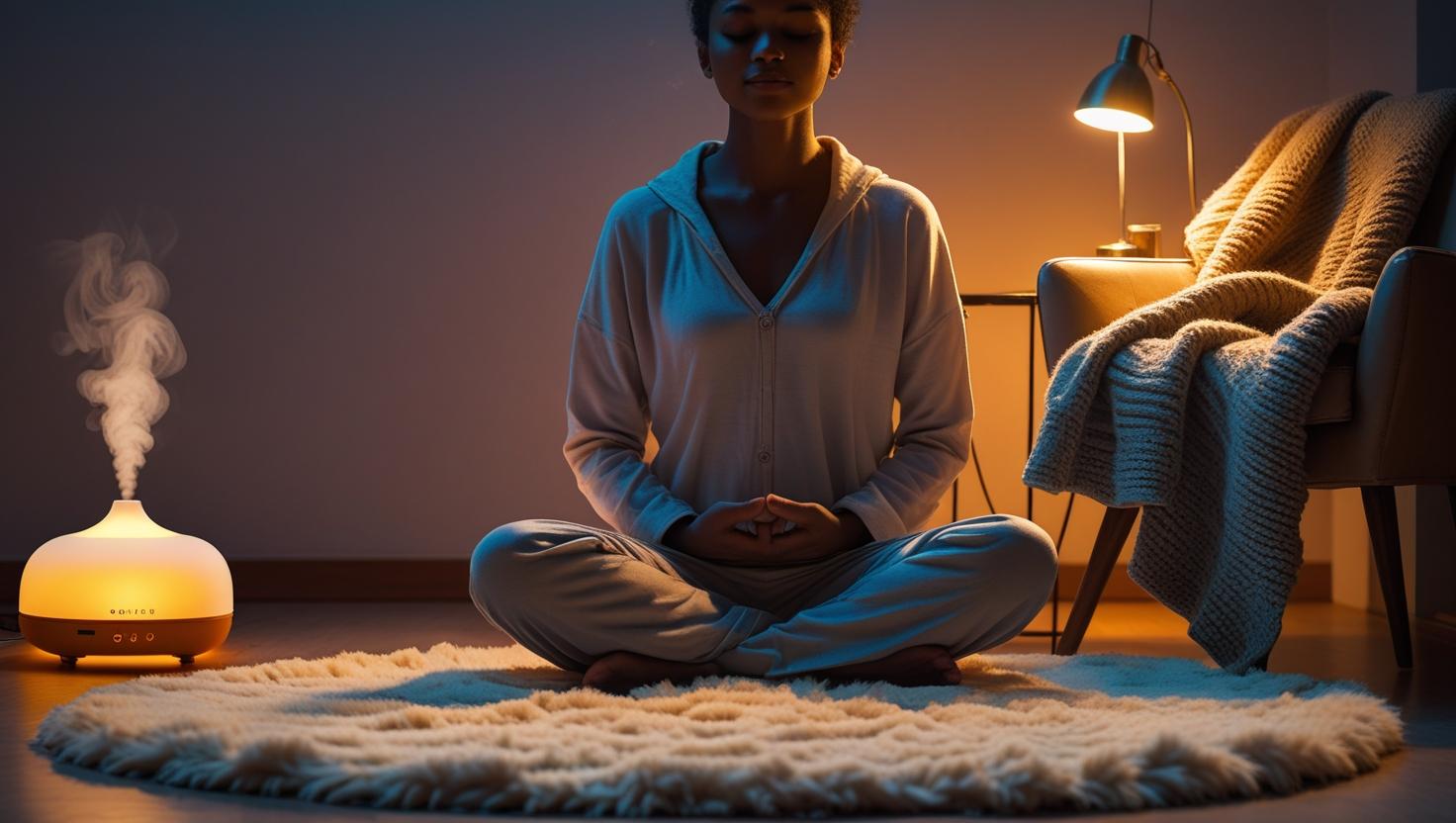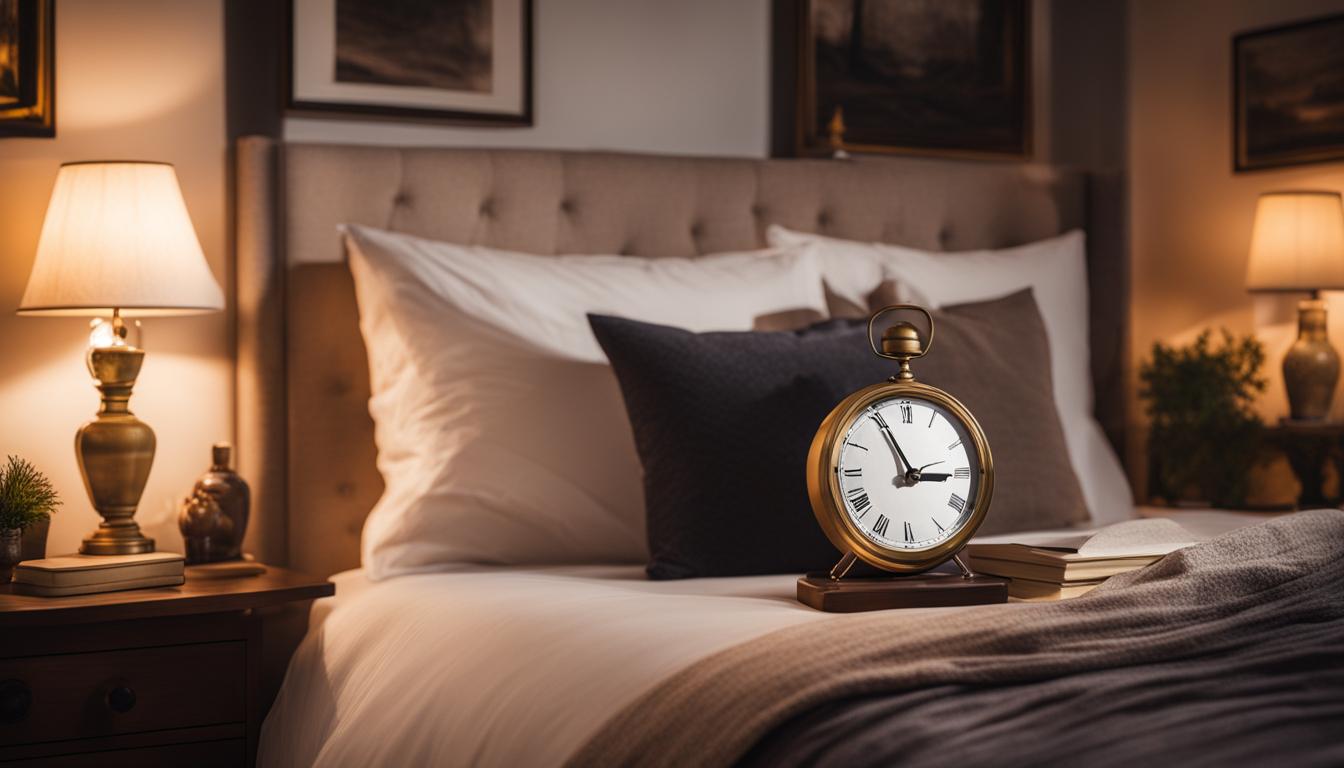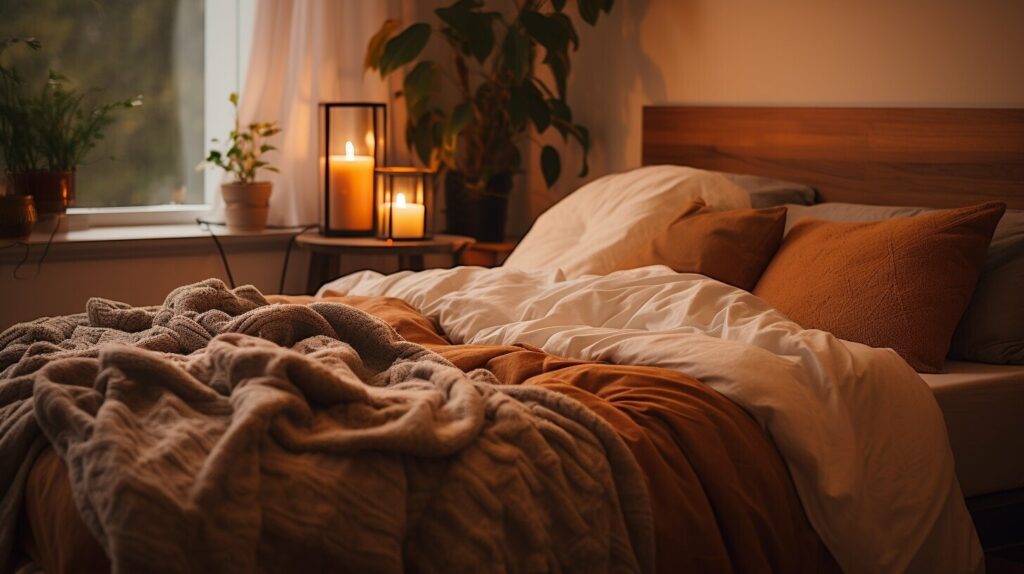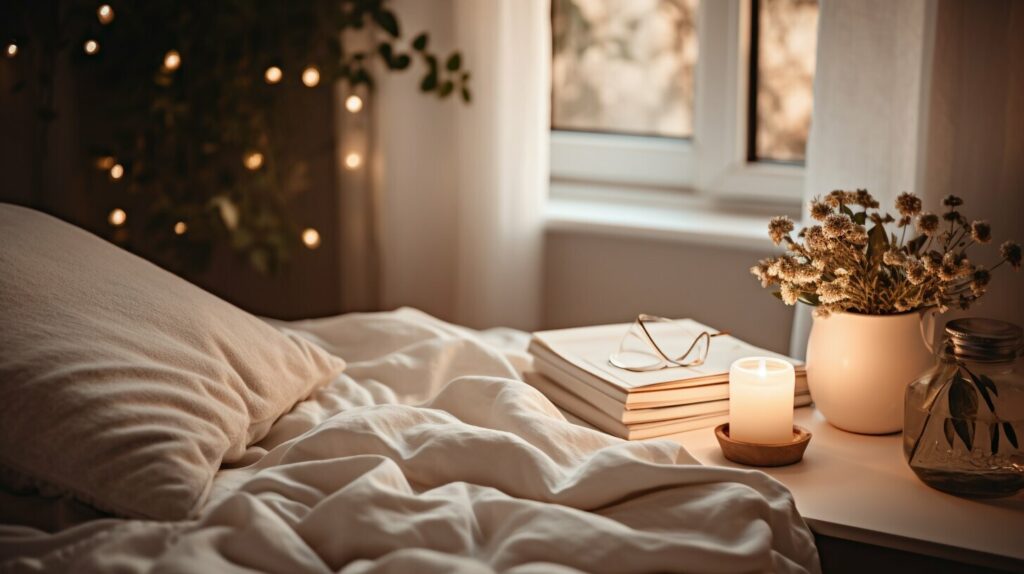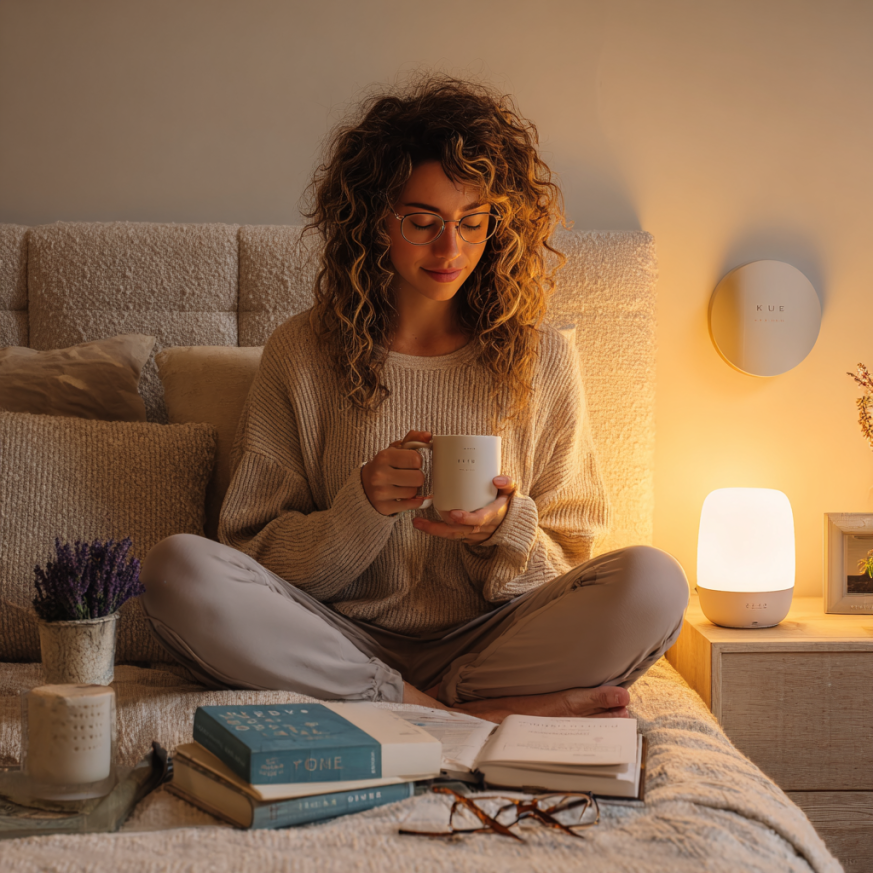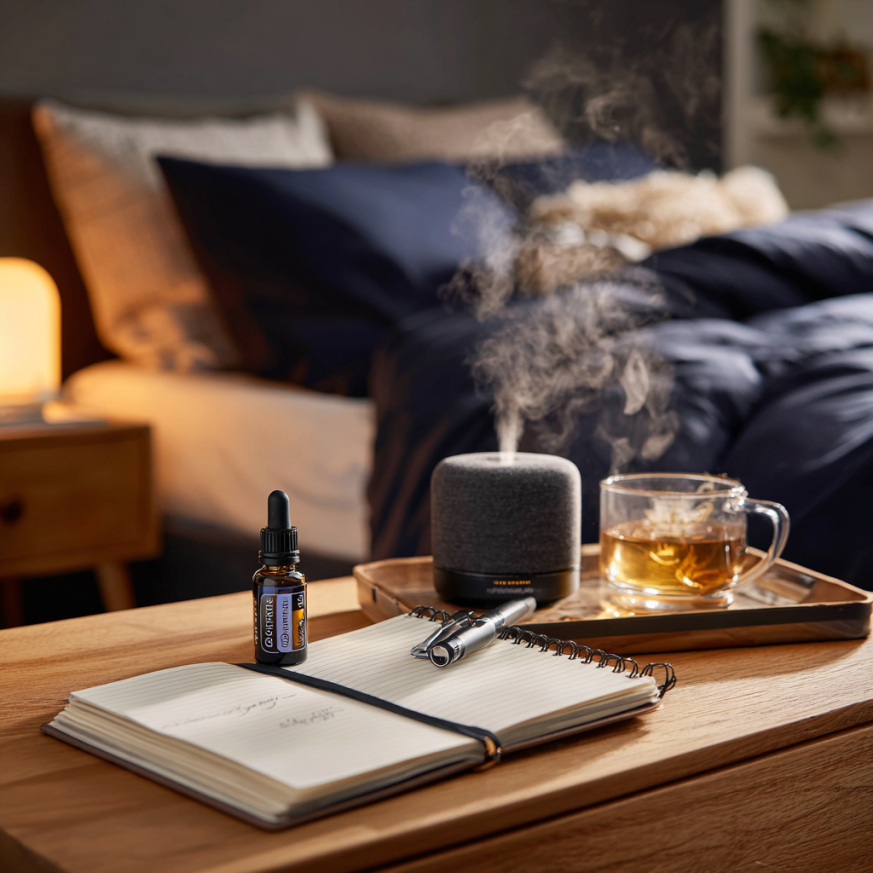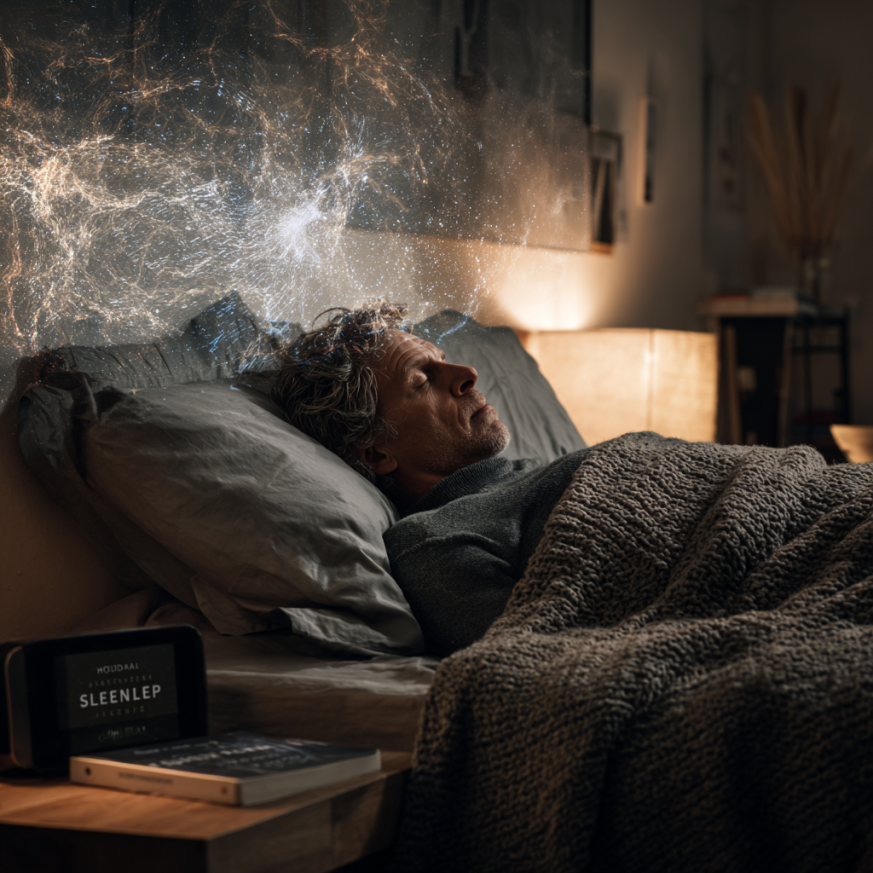Platform and Storage Beds
Looking for a bed that not only provides comfortable sleep but also offers ample storage space? Look no further than functional platform and storage beds. These beds are the perfect solution for compact living spaces, allowing you to optimize every inch of your bedroom.
One of the key advantages of platform and storage beds is their built-in storage feature. The space underneath the bed can be used to store various items such as bed linens, clothes, and other belongings. This not only helps keep your bedroom organized and tidy but also maximizes the use of space in your home.
When choosing bedroom furniture, it’s important to consider long-term plans. Storage beds with drawers can be an essential investment, especially if you’re planning to move to a smaller living space in the future. These beds provide extra storage that can make a significant difference in smaller places.
There are various popular options for platform and storage beds, catering to different sizes, colors, and material preferences. Some popular models include the Myla Side Storage Bed, Zen Kids Bed with Drawers, Pactera Oak King Storage Bed, Ebba Storage Bed, Flekke Daybed, Folsom Storage Platform Bed, Kerrissa Storage Queen Platform Bed, Mr. Kate Moon Queen Upholstered Storage Bed, Room & Board Avery Bed, Mercury Row Cletus Upholstered Low Profile Platform Bed Frame, DG Casa Argo Upholstered Panel Bed Frame with Storage Drawers, and Novogratz Brittany Upholstered Bed.
Key Takeaways:
- Platform and storage beds are a functional and space-saving solution for compact living spaces.
- They offer built-in storage underneath the bed, helping keep the bedroom organized and tidy.
- Storage beds with drawers are essential for long-term plans, especially for individuals planning future moves to smaller spaces.
- Popular options include the Myla Side Storage Bed, Zen Kids Bed with Drawers, Pactera Oak King Storage Bed, and more.
- These beds come in various sizes, colors, and materials, providing ample storage space while maintaining style and comfort.
Why Choose Platform and Storage Beds?
Platform and storage beds are the perfect choice for modern homes, providing space-saving designs that meet your unique needs and instantly upgrade your bedroom. These beds are designed with built-in storage underneath, allowing you to maximize every inch of space in your bedroom. Whether you have a small apartment or a large household, platform and storage beds offer the perfect solution to keep your bedroom organized and tidy.
One of the main advantages of choosing platform and storage beds is their ability to optimize space in compact living areas. The built-in storage underneath the bed provides ample space to store bed linens, clothes, or other items, keeping them easily accessible yet hidden from view. This not only helps in maximizing storage space but also contributes to a clutter-free and organized bedroom environment.
Furthermore, platform and storage beds cater to individual needs and style preferences. They come in various sizes, colors, and materials, allowing you to choose a bed that complements your bedroom decor. Whether you prefer a sleek and minimalistic design or a more traditional and elegant style, there is a wide range of options available to suit your taste.

| Popular Options for Storage Beds |
|---|
| Myla Side Storage Bed |
| Zen Kids Bed with Drawers |
| Pactera Oak King Storage Bed |
| Ebba Storage Bed |
| Flekke Daybed |
When it comes to long-term plans, such as future moves to smaller living spaces, storage beds with drawers become even more essential. These beds provide extra storage that can accommodate your belongings in a more compact setting. By choosing a storage bed, you ensure that you don’t compromise on space while still having plenty of room to store your essentials.
Conclusion
Platform and storage beds offer functional and stylish solutions for modern bedrooms. They provide space-saving designs that optimize storage space while meeting individual needs and style preferences. Whether you are looking to upgrade your bedroom or planning for the future, platform and storage beds are a versatile and practical choice that enhances both functionality and aesthetics in your space.
The Benefits of Storage Beds
Storage beds offer more than just a comfortable place to sleep – they provide built-in storage solutions that enhance bedroom organization and ensure accessible bedding for everyone in the household. With their clever design, storage beds utilize the often-underutilized space beneath the mattress, offering ample room to store bed linens, clothes, and other items. This built-in storage eliminates the need for bulky dressers or overflowing closets, creating a more streamlined and organized bedroom.
One of the key benefits of storage beds is their ability to keep the bedroom tidy and clutter-free. With easy access to stored items, such as extra blankets or seasonal clothing, you can maintain a clean and organized sleeping space. No more digging through drawers or rummaging in the closet – everything you need is conveniently stored right beneath your mattress.
Storage beds are especially beneficial for large households or shared bedrooms. By providing individual storage compartments, each family member or occupant can have their own designated space, ensuring accessible bedding for everyone. This eliminates the hassle of searching for misplaced items or sorting through mixed-up linens. Each person can easily locate their own bedding and keep their personal belongings stored neatly and securely.
| Popular Options for Storage Beds |
|---|
| Myla Side Storage Bed |
| Zen Kids Bed with Drawers |
| Pactera Oak King Storage Bed |
| Ebba Storage Bed |
| Flekke Daybed |
| Folsom Storage Platform Bed |
| Kerrissa Storage Queen Platform Bed |
| Mr. Kate Moon Queen Upholstered Storage Bed |
| Room & Board Avery Bed |
| Mercury Row Cletus Upholstered Low Profile Platform Bed Frame |
| DG Casa Argo Upholstered Panel Bed Frame with Storage Drawers |
| Novogratz Brittany Upholstered Bed |

Future-Proofing with Storage Beds
Thinking ahead is essential when it comes to furnishing your bedroom, especially if you anticipate future moves to smaller spaces – storage beds with drawers provide the necessary extra storage for optimizing limited square footage. These beds offer a practical solution for those who want to make the most out of their space without compromising on style or comfort.
Storage beds come in a variety of styles, sizes, colors, and materials, ensuring that you can find the perfect match for your bedroom decor. Whether you prefer a sleek and modern platform bed or a cozy upholstered frame, there are numerous options available to suit your taste and needs.
Not only do storage beds provide additional storage space for items like bed linens and clothes, but they also help in keeping your bedroom organized and tidy. The built-in drawers or compartments underneath the bed make it easy to access your belongings while keeping them neatly out of sight.
Investing in a storage bed is a smart choice for those looking to maximize their bedroom space and plan for the future. Whether you’re downsizing to a smaller home or simply want to optimize your current living situation, a storage bed offers a practical solution for keeping your belongings organized and your space clutter-free.
Popular Options for Storage Beds
There are several popular options for storage beds that combine functionality with style. The Myla Side Storage Bed and Zen Kids Bed with Drawers are excellent choices for those looking for sleek, modern designs. If you prefer a more rustic look, the Pactera Oak King Storage Bed and Ebba Storage Bed offer a warm and inviting appeal.
- Myla Side Storage Bed
- Zen Kids Bed with Drawers
- Pactera Oak King Storage Bed
- Ebba Storage Bed
- Flekke Daybed
- Folsom Storage Platform Bed
- Kerrissa Storage Queen Platform Bed
- Mr. Kate Moon Queen Upholstered Storage Bed
- Room & Board Avery Bed
- Mercury Row Cletus Upholstered Low Profile Platform Bed Frame
- DG Casa Argo Upholstered Panel Bed Frame with Storage Drawers
- Novogratz Brittany Upholstered Bed
With these popular options, you can find a storage bed that meets your storage needs while enhancing the overall aesthetic of your bedroom. Don’t compromise on space or style – choose a storage bed that offers both functionality and design.
| Bed | Material | Color | Size |
|---|
| Myla Side Storage Bed | Wood | Gray | Queen |
| Zen Kids Bed with Drawers | Wood | White | Twin |
| Pactera Oak King Storage Bed | Oak Wood | Brown | King |
| Ebba Storage Bed | Fabric | Beige | Full |
| Flekke Daybed | Metal | Black | Twin |

When it comes to storage beds, there are numerous options available to cater to different tastes and needs – from the sleek and modern Myla Side Storage Bed to the versatile and stylish Zen Kids Bed with Drawers. These beds not only provide a comfortable and cozy sleeping space but also offer valuable storage solutions.
One popular choice is the Pactera Oak King Storage Bed, which features a sturdy oak frame and spacious built-in drawers, perfect for storing extra linens, clothing, or personal items. If you’re looking for a bed that combines functionality with contemporary design, the Ebba Storage Bed is an excellent option. Its clean lines and minimalist aesthetic make it a standout piece in any bedroom.
For smaller spaces or guest rooms, the Flekke Daybed is a smart choice. This versatile bed not only provides a comfortable sleeping area but also offers under-bed storage that can easily accommodate extra bedding or seasonal items. Another stylish and functional option is the Folsom Storage Platform Bed, which features a low-profile design and convenient storage drawers, making it an ideal choice for those seeking modern elegance.
Whether you prefer classic or contemporary styles, there is a storage bed to suit your needs. From the elegant Kerrissa Storage Queen Platform Bed to the luxurious Mr. Kate Moon Queen Upholstered Storage Bed, you’ll find a wide range of options to match your bedroom decor and personal style. Other popular choices include the Room & Board Avery Bed, Mercury Row Cletus Upholstered Low Profile Platform Bed Frame, DG Casa Argo Upholstered Panel Bed Frame with Storage Drawers, and the Novogratz Brittany Upholstered Bed.
| Bed Model | Description |
|---|
| Myla Side Storage Bed | Sleek and modern design with built-in storage drawers |
| Zen Kids Bed with Drawers | Versatile and stylish bed with ample storage space |
| Pactera Oak King Storage Bed | Sturdy oak frame with spacious built-in drawers |
| Ebba Storage Bed | Contemporary design with clean lines and minimalist aesthetic |
| Flekke Daybed | Smart solution for smaller spaces with under-bed storage |
| Folsom Storage Platform Bed | Modern elegance with low-profile design and storage drawers |
| Kerrissa Storage Queen Platform Bed | Elegant and functional design for a queen-sized bed |
| Mr. Kate Moon Queen Upholstered Storage Bed | Luxurious bed with upholstered headboard and built-in storage |
| Room & Board Avery Bed | Classic design with ample storage space |
| Mercury Row Cletus Upholstered Low Profile Platform Bed Frame | Sleek and stylish bed frame with storage functionality |
| DG Casa Argo Upholstered Panel Bed Frame with Storage Drawers | Elegant and functional bed frame with storage drawers |
| Novogratz Brittany Upholstered Bed | Stylish and comfortable bed with under-bed storage |
With such a wide variety of options, you can find the perfect storage bed that not only meets your storage needs but also complements your personal style. These beds offer practicality without compromising on style, making them a valuable addition to any bedroom.

For those seeking an elegant and functional sleeping solution, canopy beds offer a perfect blend of style and practicality. These timeless pieces of furniture not only add a touch of grandeur to the bedroom but also provide ample storage space to keep your belongings organized and within easy reach.
Canopy beds are known for their distinctive design, featuring four posts that extend vertically from each corner of the bed, supporting a frame or canopy overhead. This canopy can be draped with sheer fabrics to create a dreamy and romantic atmosphere, or left open for a more minimalist look.
One of the key advantages of canopy beds is their versatility. They come in various sizes, from twin to king, and can be found in a wide range of styles, materials, and finishes to suit different tastes and bedroom décors. Whether you prefer a sleek and modern design or a more traditional and ornate look, there is a canopy bed option to match your personal style and preference.

Furthermore, canopy beds often come with built-in storage features, such as drawers, shelves, or hidden compartments. These storage solutions allow you to maximize the functionality of your bed space, providing a convenient place to store extra bedding, clothing, or other items, while keeping them neatly out of sight.
Canopy Bed Styles
When choosing a canopy bed, consider the different styles available:
- Traditional canopy beds feature intricate carvings and ornamental details, perfect for those who appreciate classic elegance.
- Contemporary canopy beds offer a sleek and minimalist design, with clean lines and a focus on simplicity.
- Canopy beds with storage combine the beauty of a canopy design with the practicality of additional storage space, providing a functional and stylish solution for smaller bedrooms.
With their timeless appeal and practical storage solutions, canopy beds are an excellent choice for those seeking a beautiful and functional addition to their bedroom. Whether you want to create a cozy and intimate space or make a stylish statement, a canopy bed can transform your bedroom into a luxurious retreat.
| Popular Canopy Bed Options | Size | Material | Color |
|---|
| Myla Side Storage Bed | Queen | Wood | White |
| Zen Kids Bed with Drawers | Twin | Metal | Black |
| Pactera Oak King Storage Bed | King | Oak | Brown |
If you have limited space or need to accommodate multiple sleepers, bunk beds are an excellent choice for maximizing sleeping space without sacrificing style or comfort. Bunk beds are not just for children’s bedrooms; they have become increasingly popular in adult bedrooms and guest rooms as well. These beds feature a space-saving design, with one bed stacked on top of another. This allows you to utilize vertical space, leaving more floor space available for other furniture or activities.
Bunk beds come in a variety of styles and sizes to suit your needs and preferences. Whether you prefer a modern, sleek design or a classic and sturdy wooden frame, there is a bunk bed that will fit your aesthetic. Additionally, bunk beds often feature built-in storage options, such as drawers or shelves, providing additional space to keep belongings organized. This is especially useful in smaller living spaces where every inch of storage matters.
To give you an idea of the range of options available, here are some popular models and styles of bunk beds:
1. Twin over twin bunk bed with built-in storage drawers
2. Full over full bunk bed with ladder and guardrails
3. Loft bunk bed with a desk and shelves underneath
4. L-shaped bunk bed with a workstation and bookshelves
5. Triple bunk bed for accommodating three sleepers
No matter which style you choose, bunk beds offer a practical and space-saving solution for maximizing sleeping space. They are not only functional but can also add a fun and playful element to any bedroom. So, if you’re looking to optimize space in your bedroom or provide comfortable sleeping arrangements for guests, consider the versatility and efficiency of bunk beds.

| Sleepers | Dimensions | Material | Price |
|---|
| 2 | 78″ x 42″ x 63″ | Wood | $399 |
| 3 | 79″ x 43″ x 77″ | Metal | $499 |
| 2 | 80″ x 58″ x 69″ | Wood | $599 |
| 4 | 82″ x 58″ x 67″ | Metal | $699 |
Murphy Beds – The Ultimate Space-Saving Solution
When it comes to space-saving solutions, Murphy beds reign supreme – these foldable beds seamlessly blend into the wall, offering a practical and stylish sleeping option. Whether you live in a small apartment or want to optimize space in a multi-functional room, Murphy beds are the perfect choice. With their ability to be easily folded up and hidden away when not in use, they provide valuable floor space that can be utilized for other activities.
Murphy beds come in various sizes and styles to suit different needs and preferences. From sleek modern designs to more traditional options, there is a Murphy bed to complement any interior décor. Some models even come with built-in storage options, allowing you to maximize the functionality of your space by storing bedding, pillows, or other items within easy reach.
One key advantage of Murphy beds is their versatility. They are not only ideal for small living spaces but also for guest rooms, home offices, or even studio apartments. By simply folding up the bed, you can instantly transform the room into a productive workspace or an entertainment area for hosting friends and family. Murphy beds offer the flexibility to adapt to your changing needs and make the most of your available space.

- Space-saving: Foldable design allows you to reclaim valuable floor space
- Stylish and versatile: Wide range of styles and sizes to match any interior
- Functional storage options: Some models feature built-in storage for added convenience
- Adaptable to different rooms: Perfect for small apartments, guest rooms, or home offices
- Ease of use: Effortlessly fold up and down without straining or damaging the bed
| Murphy Bed Models | Description |
|---|
| Model 1 | Sleek modern design with built-in storage drawers |
| Model 2 | Classic wooden frame with shelves for decorative items |
| Model 3 | Contemporary style with a hidden desk for added functionality |
If you’re looking to optimize space and add a touch of elegance to your living area, consider investing in a Murphy bed. With their innovative design and practicality, these space-saving solutions offer a comfortable sleeping option while still allowing you to make the most of your available space.
Adjustable Beds – Personalized Comfort and Functionality
Adjustable beds offer a myriad of benefits, from personalized comfort with adjustable sleeping positions to additional storage features that enhance functionality. These beds are designed to provide a customizable sleeping experience, allowing you to find the perfect position for optimal relaxation and support. Whether you prefer to elevate your head, feet, or both, adjustable beds offer various positions to alleviate discomfort and promote better sleep.
But adjustable beds go beyond adjustable sleeping positions; they also offer built-in storage solutions that help to optimize space in your bedroom. With storage drawers built into the bed frame, you can conveniently store extra bedding, pillows, or other items, keeping your bedroom organized and clutter-free. This is especially useful for those with limited closet or storage space.

Upgrade Your Sleep Experience
Investing in an adjustable bed is not only a practical choice; it can also elevate the overall look and feel of your bedroom. With a wide range of designs, materials, and sizes available, you can find an adjustable bed that complements your existing decor and fits seamlessly into your space. From sleek and modern to classic and elegant, there is an adjustable bed that suits every style.
Top Picks for Adjustable Beds
| Model | Size | Color |
|---|
| Myla Side Storage Bed | Queen | Gray |
| Zen Kids Bed with Drawers | Twin | White |
| Pactera Oak King Storage Bed | King | Oak |
These are just a few examples of the many options available. Whether you are looking for a bed with sleek lines, ample storage, or a combination of both, there is an adjustable bed out there that can meet your specific needs and preferences.
In conclusion, adjustable beds offer a range of benefits that can enhance your sleep experience and improve the functionality of your bedroom. From personalized comfort to added storage, these beds provide the perfect blend of style and practicality. So, why settle for a standard bed when you can upgrade to an adjustable bed that caters to your unique needs? Explore the options available and transform your bedroom into a haven of comfort and organization.
Sofa Beds – Dual-Purpose Furniture for Guests
Sofa beds are the ultimate dual-purpose furniture, providing comfortable seating during the day and transforming into a cozy bed for guests at night. These versatile pieces are perfect for smaller living spaces or multi-functional rooms, where maximizing functionality is essential. With a simple adjustment, you can effortlessly convert a stylish sofa into a comfortable bed, accommodating overnight guests with ease.
One of the key advantages of sofa beds is their space-saving design. Instead of dedicating a separate room for guests, you can utilize your living room or office as a guest room when needed. Sofa beds allow you to make the most of your available space without compromising on style or comfort.
When choosing a sofa bed, consider factors such as size, style, and mattress quality. Look for models that provide a seamless transition from sofa to bed, ensuring a good night’s sleep for your guests. With a wide variety of options available, you can find a sofa bed that matches your personal taste and complements your existing furniture.

- Space-saving solution for smaller living spaces or multi-functional rooms
- Comfortable seating during the day, transforming into a bed at night
- Convenient for accommodating overnight guests
- Wide variety of styles, sizes, and mattress options available
Popular Sofa Bed Models:
| Model | Description |
|---|
| Myla Side Storage Bed | Modern design with built-in storage |
| Zen Kids Bed with Drawers | Functional and stylish option for children’s rooms |
| Pactera Oak King Storage Bed | Elegant and spacious king-size bed with storage |
| Ebba Storage Bed | Contemporary design with ample storage space |
| Flekke Daybed | Versatile daybed with pull-out trundle |
Trundle Beds – Convenient Sleeping Solutions
Trundle beds are a smart and convenient sleeping solution, offering an extra bed that can be easily tucked away when not in use. These beds feature a built-in trundle, which is essentially a second bed that can be pulled out from underneath the main bed. This additional sleeping space is perfect for accommodating overnight guests or sleepovers, allowing you to make the most of your available space.
One of the greatest advantages of trundle beds is their versatility. They can be used in various settings, such as children’s bedrooms, guest rooms, or even in multi-purpose rooms that require flexible furniture options. When the trundle is not in use, it simply slides back under the main bed, making it a practical solution for maximizing space in compact living areas.
Trundle beds come in a variety of styles and designs to suit different tastes and needs. Whether you’re looking for a sleek modern design or a more traditional look, there are trundle beds available in various materials, colors, and sizes. Some trundle beds even come with additional storage drawers, providing extra space to store bedding, clothes, or toys.

| Model | Description | Size | Color |
|---|
| Myla Side Storage Bed | Modern design with built-in storage | Queen | Gray |
| Zen Kids Bed with Drawers | Perfect for children’s rooms with extra storage | Twin | White |
| Pactera Oak King Storage Bed | Classic oak bed with spacious storage drawers | King | Oak |
These are just a few examples of the many trundle bed options available on the market. Whether you have limited space or simply want to be prepared for unexpected guests, a trundle bed is an excellent choice. It combines convenience, functionality, and style, ensuring you have a comfortable and inviting sleeping solution at your disposal.
Trundle beds are the perfect solution for maximizing sleeping space while maintaining the flexibility to use the room for other purposes. With their versatile design and convenient storage options, trundle beds are a smart investment for any home.
Daybeds – Style and Function in One
Daybeds combine style and function, providing a comfortable place to relax during the day and a cozy bed for sleeping, all while incorporating storage options. These versatile pieces of furniture are perfect for smaller living spaces, multi-functional rooms, or even as a stylish addition to a larger bedroom.
With their distinct design, daybeds offer a seating area during the day, allowing you to lounge, read a book, or simply unwind. At night, they effortlessly transform into a comfortable bed, accommodating overnight guests or providing a cozy space for a restful night’s sleep.
What sets daybeds apart is their storage functionality. Many models come equipped with built-in drawers or compartments, providing convenient storage space for extra bedding, pillows, or even clothing. This makes daybeds an excellent choice for maximizing space and keeping your bedroom organized and clutter-free.

Benefits of Daybeds
Daybeds offer numerous benefits beyond their stylish appearance and space-saving design. Let’s take a closer look at why they are a popular choice:
- Versatility: Daybeds can be used in various settings, from living rooms and home offices to guest rooms and children’s rooms. They effortlessly blend into any decor style, making them a versatile addition to your home.
- Additional seating: With their comfortable cushions and supportive backrests, daybeds can serve as additional seating options when you have guests over. They provide a cozy spot for conversations, movie nights, or simply relaxing with a good book.
- Space-saving design: Daybeds are ideal for small living spaces where space optimization is a priority. They combine the functions of a sofa and a bed in one compact piece of furniture, making them perfect for studio apartments or rooms with limited square footage.
- Convenient storage: The built-in storage drawers or compartments in daybeds offer a practical solution for organizing your belongings. You can easily store extra bedding, pillows, or even books and magazines within arm’s reach, eliminating the need for additional storage furniture.
Whether you’re looking to create a cozy reading nook, accommodate guests, or simply add a stylish element to your bedroom, daybeds are a fantastic choice. They seamlessly blend style and functionality, providing a comfortable place to relax and sleep while incorporating storage options to keep your space tidy and organized.
| Popular Daybed Options | Material | Dimensions | Storage |
|---|
| Flekke Daybed | Wood | 78.75″L x 41″W x 33.5″H | 2 large drawers |
| Mr. Kate Moon Queen Upholstered Storage Bed | Upholstered | 87″L x 62.5″W x 35″H | Under-bed drawer |
| Room & Board Avery Bed | Wood | 86″L x 65″W x 19″H | Under-bed drawer |
Futons – Versatile and Space-Saving
Futons are the epitome of versatility, seamlessly transforming from a comfortable sofa into a bed, all while saving precious space in your home. Whether you live in a small apartment or need a multi-functional piece of furniture for a guest room or office, futons provide the perfect solution.
With their adjustable frames and foldable mattresses, futons offer a convenient way to maximize your living space. During the day, you can use them as stylish seating options, perfect for lounging or entertaining guests. Then, when the night falls, you can easily convert them into a cozy bed, ensuring a good night’s sleep for yourself or your visitors.
One of the greatest advantages of futons is their versatility in design. They come in various styles, colors, and materials, allowing you to choose the one that best complements your existing décor. Whether you prefer a modern, minimalist look or a more traditional aesthetic, there is a futon out there for you.
When it comes to buying a futon, it’s important to consider factors such as size, mattress thickness, and ease of conversion. Additionally, you may want to look for futons with built-in storage compartments, providing extra space to keep your blankets, pillows, or other essentials conveniently tucked away.

| Advantages of Futons | Disadvantages of Futons |
|---|
- Space-saving design
- Easy conversion between sofa and bed
- Versatile styles and materials
- Convenient storage options
- Cost-effective compared to traditional beds
| - Mattress may be less comfortable than traditional beds
- May not provide adequate support for individuals with back issues
- Some models may be difficult to assemble
- Limited seating capacity compared to larger sofas
|
Quotes:
“A futon is a versatile piece of furniture that can transform any space into a functional living area,” says interior design expert Jane Smith. “With their space-saving design and customizable features, futons offer a practical and stylish solution for those with limited square footage.”
“Futons are an excellent choice for small apartments or guest rooms,” explains furniture specialist John Doe. “They provide a comfortable seating area during the day and can quickly convert into a bed for overnight guests. Plus, the storage options available in some futon models are a great bonus for keeping your living space organized.”
| Popular Futon Styles |
|---|
| Style | Description |
| Traditional Futon | A classic design featuring a wooden frame and a comfortable cotton-filled mattress |
| Modern Futon | Sleek and minimalistic, often made with metal or leather-like materials |
| Gaming Futon | Perfect for gaming enthusiasts, with additional features like built-in speakers and charging ports |
| Convertible Futon | A multifunctional option that can transform into a chaise lounge or even a sectional sofa |
Four-Poster Beds – Classic Elegance with Storage
Four-poster beds exude classic elegance and can be customized with storage options, ensuring a luxurious yet functional sleeping experience. These beds are characterized by their tall, decorative posts at each corner, creating an air of grandeur and sophistication in any bedroom.
What sets four-poster beds apart from other bed styles is their ability to incorporate built-in storage, providing a practical solution for those seeking a combination of style and functionality. Whether it’s drawers discreetly tucked away beneath the mattress or a hidden compartment at the foot of the bed, these storage options allow you to optimize space while maintaining a visually pleasing aesthetic.
Imagine having extra storage compartments to keep your bed linens, blankets, or even seasonal clothing close at hand, yet neatly concealed from view. With four-poster beds, you can create a clutter-free environment while adding an element of luxury to your sleep sanctuary.
| Popular Four-Poster Beds | Features |
|---|
| Myla Side Storage Bed | Built-in side storage compartments |
| Zen Kids Bed with Drawers | Multiple drawers for kids’ essentials |
| Pactera Oak King Storage Bed | Spacious under-bed storage |
| Ebba Storage Bed | Hidden storage at the footboard |

These are just a few examples of the popular four-poster bed models available. They come in various sizes, materials, and finishes, allowing you to find the perfect fit for your bedroom decor. Whether you prefer a classic wooden design or a more contemporary look, there is a four-poster bed to suit every style.
Experience the timeless elegance and functional storage of a four-poster bed, and transform your bedroom into a luxurious retreat that combines style with practicality.
Sleigh Beds – Stylish and Storage-Friendly
Sleigh beds offer a blend of style and functionality, with their distinctive curved design and built-in storage compartments providing a practical yet fashionable option. These elegant beds have a timeless appeal that adds a touch of sophistication to any bedroom. The curved headboard and footboard create a sense of luxury, making sleigh beds a focal point in the room.
What sets sleigh beds apart is their ability to combine style with storage. Many sleigh beds are designed with built-in storage compartments underneath the mattress, offering a convenient solution for keeping your bedroom organized and clutter-free. These storage compartments are perfect for storing extra bed linens, pillows, or seasonal clothing, allowing you to maximize the space in your bedroom.
“Sleigh beds not only provide a comfortable place to sleep but also serve as an elegant storage solution, helping you make the most of your bedroom space.” – Interior Design Magazine
When it comes to choosing a sleigh bed, you have a variety of options to suit your style and needs. Whether you prefer a classic wooden sleigh bed or a more modern upholstered design, there are endless possibilities to choose from. Popular options for sleigh beds include the Myla Side Storage Bed, Zen Kids Bed with Drawers, Pactera Oak King Storage Bed, Ebba Storage Bed, and Flekke Daybed.
| Sleigh Bed Model | Description | Material | Storage Type |
|---|
| Myla Side Storage Bed | Elegant and versatile, featuring side storage compartments for easy access. | Wood | Side drawers |
| Zen Kids Bed with Drawers | Designed with kids in mind, providing ample storage space for toys and essentials. | Wood | Underbed drawers |
| Pactera Oak King Storage Bed | A king-size sleigh bed with spacious underbed storage for a clutter-free bedroom. | Oak | Underbed storage |
| Ebba Storage Bed | A sleek and modern sleigh bed with hidden storage compartments for a minimalist look. | Upholstery | Hidden compartments |
| Flekke Daybed | A versatile daybed with a trundle and storage drawers, perfect for guest rooms or small spaces. | Wood | Trundle bed and drawers |
Whether you’re looking to upgrade your bedroom with a stylish and functional bed or optimize space in a smaller room, sleigh beds offer a perfect balance of style and storage. With their elegant design and built-in storage compartments, these beds provide the best of both worlds, allowing you to create a sophisticated and organized bedroom.

Functional platform and storage beds are a game-changer for any bedroom, offering space-saving solutions, ample storage, and a touch of style to upgrade your sleeping space. These beds are specifically designed to optimize space in compact living areas, making them a perfect choice for those who are in need of additional storage without compromising on style or comfort.
One of the key advantages of storage beds is the built-in storage underneath the bed, which allows you to store bed linens, clothes, or other items conveniently. This not only helps in keeping your bedroom organized and tidy but also ensures that everyone’s bedding is easily accessible, particularly in large households.
When planning for the future, be it a move to a smaller living space or simply considering long-term needs, storage beds with drawers become essential. These beds provide extra storage that is valuable in smaller places, allowing you to make the most of the available space while keeping your possessions neatly stored away.
With a wide range of popular options available, such as the Myla Side Storage Bed, Zen Kids Bed with Drawers, Pactera Oak King Storage Bed, and the Ebba Storage Bed, you can find a storage bed that suits your specific preferences and requirements. These beds come in various sizes, colors, and materials, ensuring that you can find one that perfectly complements your bedroom decor while providing ample storage space. Functional platform and storage beds truly offer the best of both worlds – practicality and style.
FAQ
Q: What are the benefits of platform and storage beds?
A: Platform and storage beds are an excellent solution for compact living spaces. They provide functional benefits by optimizing space and offering built-in storage options for bed linens, clothes, and other items.
Q: Why should I choose platform and storage beds?
A: Platform and storage beds are a great choice if you want to upgrade your bedroom while maximizing space. They cater to unique needs and style preferences, providing a stylish and functional solution.
Q: What are the benefits of storage beds?
A: Storage beds offer the convenience of built-in storage, helping to keep your bedroom organized and tidy. With storage space for bed linens, clothes, and other items, they ensure accessible bedding and a clutter-free environment.
Q: How do storage beds future-proof my bedroom?
A: Storage beds are an excellent choice for individuals or families planning future moves to smaller living spaces. They provide essential extra storage, which becomes even more valuable in smaller places.
Q: What are some popular options for storage beds?
A: Some popular options for storage beds include the Myla Side Storage Bed, Zen Kids Bed with Drawers, Pactera Oak King Storage Bed, Ebba Storage Bed, Flekke Daybed, Folsom Storage Platform Bed, Kerrissa Storage Queen Platform Bed, Mr. Kate Moon Queen Upholstered Storage Bed, Room & Board Avery Bed, Mercury Row Cletus Upholstered Low Profile Platform Bed Frame, DG Casa Argo Upholstered Panel Bed Frame with Storage Drawers, and Novogratz Brittany Upholstered Bed.
Q: What are canopy beds?
A: Canopy beds combine elegance with functionality. They add a touch of sophistication to your bedroom while still providing the benefits of storage space.
Q: How do bunk beds maximize sleeping space?
A: Bunk beds are an excellent choice for maximizing sleeping space, especially in shared bedrooms or when accommodating guests. They allow multiple beds to be stacked on top of each other, saving valuable floor space.
Q: What are Murphy beds?
A: Murphy beds are the ultimate space-saving solution. They can be effortlessly folded up to create extra floor space when not in use, making them perfect for smaller living spaces.
Q: What are adjustable beds?
A: Adjustable beds offer personalized comfort and functionality. They allow you to customize your sleeping positions and often come with built-in storage options for added convenience.
Q: What are sofa beds?
A: Sofa beds are dual-purpose furniture that serve as both seating and sleeping options. They are ideal for accommodating overnight guests without the need for extra sleeping space.
Q: What are trundle beds?
A: Trundle beds are convenient sleeping solutions. They feature an additional bed hidden underneath the main bed, perfect for accommodating overnight guests or sleepovers.
Q: What are daybeds?
A: Daybeds offer style and function in one. They serve as both seating and sleeping options while also providing storage space.
Q: What are futons?
A: Futons are versatile and space-saving furniture pieces. They can serve as both a sofa and a bed, making them perfect for smaller living spaces or multi-functional rooms.
Q: What are four-poster beds?
A: Four-poster beds combine classic elegance with storage features. They add a touch of grandeur to the bedroom while providing ample storage space.
Q: What are sleigh beds?
A: Sleigh beds are stylish and storage-friendly. They feature curved headboards and footboards, along with convenient storage compartments, combining style and functionality.
Source Links







